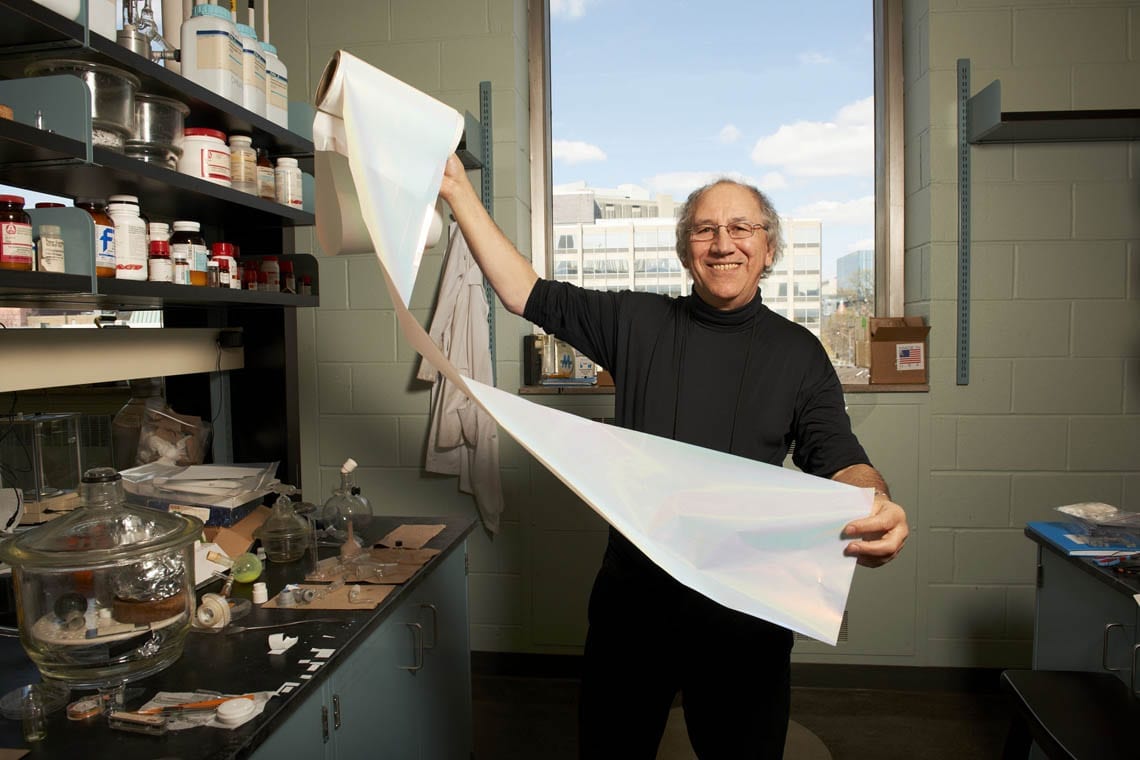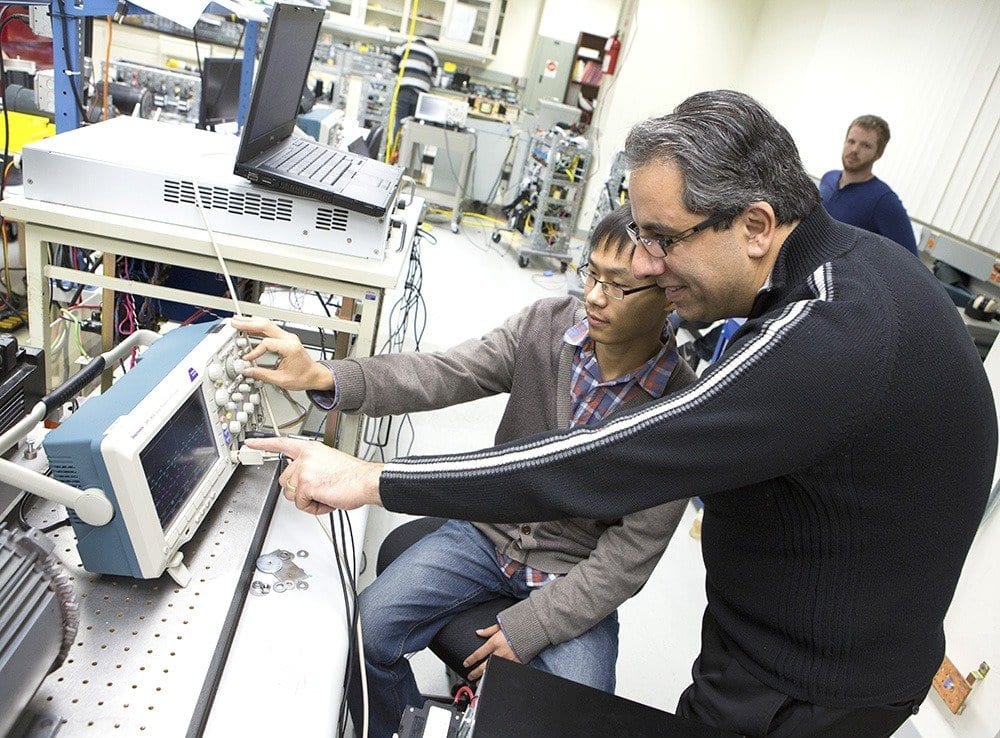
Every year, humans advance climate change and global warming – and quite likely our own eventual extinction – by injecting about 30 billion tonnes of carbon dioxide (CO?) into the atmosphere.
A team of U of T scientists believes they’ve found a way to convert all these emissions into energy-rich fuel in a carbon-neutral cycle that uses a very abundant natural resource: silicon. Silicon, readily available in sand, is the seventh most-abundant element in the universe and the second most-abundant element in the earth’s crust.
The idea of converting CO? emissions to energy isn’t new: there’s been a global race to discover a material that can efficiently convert sunlight, carbon dioxide and water or hydrogen to fuel for decades. However, the chemical stability of CO? has made it difficult to find a practical solution.
“A chemistry solution to climate change requires a material that is a highly active and selective catalyst to enable the conversion of CO? to fuel. It also needs to be made of elements that are low cost, non-toxic and readily available,” said Faculty of Arts & Science chemistry professor Geoffrey Ozin, the Canada Research Chair in Materials Chemistry and lead of U of T’s Solar Fuels Research Cluster.
In an article in Nature Communications published August 23, Ozin and colleagues report silicon nanocrystals that meet all the criteria. The hydride-terminated silicon nanocrystals – nanostructured hydrides for short – have an average diameter of 3.5 nanometres and feature a surface area and optical absorption strength sufficient to efficiently harvest the near-infrared, visible and ultraviolet wavelengths of light from the sun together with a powerful chemical-reducing agent on the surface that efficiently and selectively converts gaseous carbon dioxide to gaseous carbon monoxide.
The potential result: energy without harmful emissions.
“Making use of the reducing power of nanostructured hydrides is a conceptually distinct and commercially interesting strategy for making fuels directly from sunlight,” said Ozin.
The U of T Solar Fuels Research Cluster is working to find ways and means to increase the activity, enhance the scale, and boost the rate of production. Their goal is a laboratory demonstration unit and, if successful, a pilot solar refinery.
Learn more: U of T scientists solve puzzle of converting CO? emissions to fuel
The Latest on: Converting CO2 emissions to fuel
[google_news title=”” keyword=”converting CO2 emissions to fuel” num_posts=”10″ blurb_length=”0″ show_thumb=”left”]
via Google News
The Latest on: Converting CO2 emissions to fuel
- Aviation has sustainability targets but demand for air travel is soaringon May 17, 2024 at 11:22 am
Over the coming years, the transport sector will have to shift dramatically to meet sustainability goals. The push towards the adoption of electric cars has been ongoing for years but will have to ...
- Carbon-capture batteries developed to store renewable energy, help climateon May 16, 2024 at 5:36 am
Researchers are developing battery technologies to fight climate change in two ways, by expanding the use of renewable energy and capturing airborne carbon dioxide. Researchers recently created and ...
- Clearing The Air: Why Carbon Storage Must Be Part Of The Solutionon May 15, 2024 at 4:30 am
When people talk about the climate crisis, they tend to agree on one primary solution: Cut carbon dioxide emissions.
- Inspired by natureon May 14, 2024 at 5:00 pm
Converting carbon dioxide into methanol, a potentially renewable alternative fuel, offers an opportunity to simultaneously form an alternative fuel and cut down on carbon dioxide emissions. Inspired ...
- University of Michigan researchers leap toward carbon neutrality converting CO2 to methanolon May 10, 2024 at 2:30 am
Ann Arbor, MI – Researchers at the University of Michigan have developed a catalyst material known as cobalt phthalocyanine that converts carbon dioxide—a significant driver of climate change—into ...
- Technological leap turns carbon dioxide (CO2) into methanol fuelon May 9, 2024 at 5:47 pm
Researchers have discovered a way to convert carbon dioxide (CO2) into methanol, offering a pathway to reduce greenhouse gas emissions ...
- Renewable diesel, not electric, key to cutting trucking emissions: Reporton May 8, 2024 at 5:00 pm
As part of its ongoing research into the lifecycle emissions of diesel-powered trucks compared to alternative-fuel trucks, the American Transportation ... That study found a potential 30% decrease in ...
- Towards Carbon Neutrality: New Catalyst Converts Carbon Dioxide to Renewable Fuelon May 7, 2024 at 5:00 pm
This approach presents a sustainable method for reducing greenhouse gas emissions while offering an avenue ... catalysts like cobalt phthalocyanine to efficiently convert CO2 waste into methanol fuel ...
- ATRI: Renewable Diesel Better Emissions Option than BEVson May 1, 2024 at 1:39 pm
A new study by the American Transportation Research Institute has found that widescale use of renewable diesel fuel would be substantially cheaper than the adoption of electric trucks while delivering ...
- Reducing carbon emissions: Egypt’s project to replace and convert cars to run on natural gason April 24, 2024 at 5:00 pm
The fuel conversion project aims to reduce harmful ... lower emissions of carbon monoxide and 25 percent lower carbon dioxide emissions. The report also cited the UN Economic Commission for ...
via Bing News











